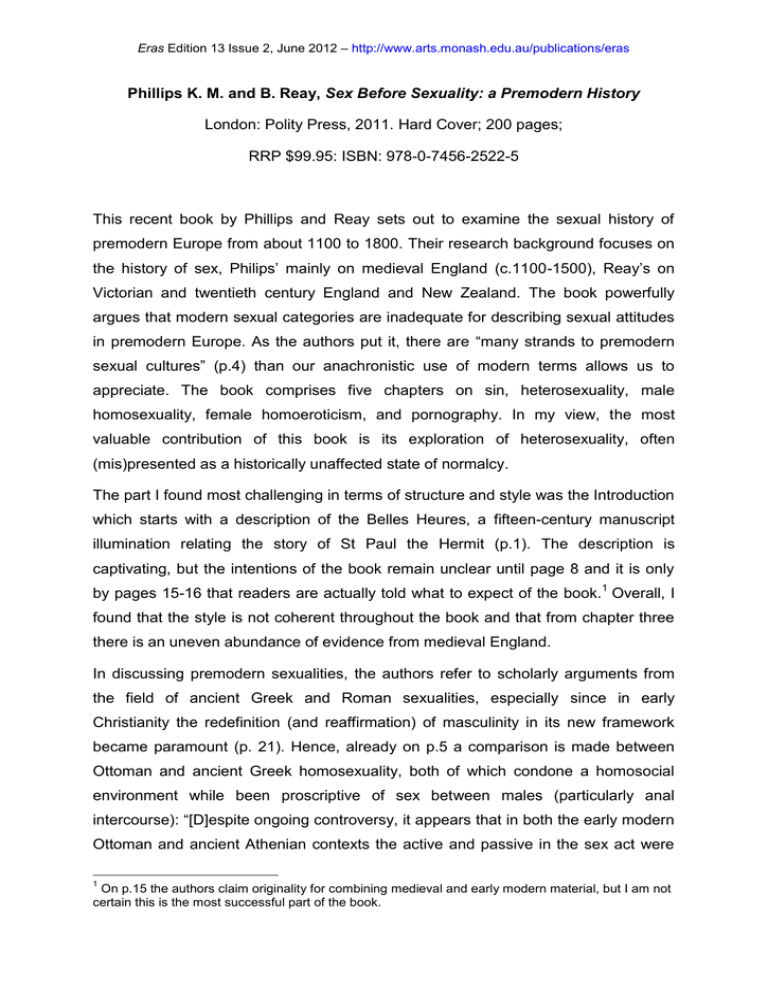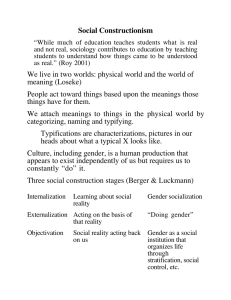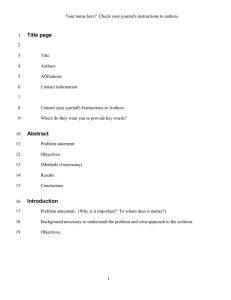
Eras Edition 13 Issue 2, June 2012 – http://www.arts.monash.edu.au/publications/eras
Phillips K. M. and B. Reay, Sex Before Sexuality: a Premodern History
London: Polity Press, 2011. Hard Cover; 200 pages;
RRP $99.95: ISBN: 978-0-7456-2522-5
This recent book by Phillips and Reay sets out to examine the sexual history of
premodern Europe from about 1100 to 1800. Their research background focuses on
the history of sex, Philips’ mainly on medieval England (c.1100-1500), Reay’s on
Victorian and twentieth century England and New Zealand. The book powerfully
argues that modern sexual categories are inadequate for describing sexual attitudes
in premodern Europe. As the authors put it, there are “many strands to premodern
sexual cultures” (p.4) than our anachronistic use of modern terms allows us to
appreciate. The book comprises five chapters on sin, heterosexuality, male
homosexuality, female homoeroticism, and pornography. In my view, the most
valuable contribution of this book is its exploration of heterosexuality, often
(mis)presented as a historically unaffected state of normalcy.
The part I found most challenging in terms of structure and style was the Introduction
which starts with a description of the Belles Heures, a fifteen-century manuscript
illumination relating the story of St Paul the Hermit (p.1). The description is
captivating, but the intentions of the book remain unclear until page 8 and it is only
by pages 15-16 that readers are actually told what to expect of the book.1 Overall, I
found that the style is not coherent throughout the book and that from chapter three
there is an uneven abundance of evidence from medieval England.
In discussing premodern sexualities, the authors refer to scholarly arguments from
the field of ancient Greek and Roman sexualities, especially since in early
Christianity the redefinition (and reaffirmation) of masculinity in its new framework
became paramount (p. 21). Hence, already on p.5 a comparison is made between
Ottoman and ancient Greek homosexuality, both of which condone a homosocial
environment while been proscriptive of sex between males (particularly anal
intercourse): “[D]espite ongoing controversy, it appears that in both the early modern
Ottoman and ancient Athenian contexts the active and passive in the sex act were
1
On p.15 the authors claim originality for combining medieval and early modern material, but I am not
certain this is the most successful part of the book.
Eras Edition 13 Issue 2, June 2012 – http://www.arts.monash.edu.au/publications/eras
conceived differently. Those prone to committing sodomy exhibited moral failure
rather than sexual pathology in ways that will become familiar from the pages below.”
What troubles this reviewer about the aforementioned comparison is that, in an
attempt to highlight the fluid perception of sexualities in past societies in general, it
almost conflates (surely not intentionally) ancient Greek and Ottoman homosexual
practices without commenting enough on their differences.2 For a book that focuses
on our rushed presumptions regarding premodern sexualities, I often felt that wordy
explanations were included where not necessary (i.e. see pages 6-9 discussing sex
versus gender) while lacking in other places, just as the one described above,
particularly as this point is not picked up later on.
Relating to the previous point, I also wondered whether more systematic references
to the rediscovery of the classical texts and their influence on the ways people
appreciated their sexual self by comparison would enrich the arguments, especially
regarding the less evidenced representation of female homoeroticism.3 This would
also perhaps pave the way for greater overall attention to literary conventions as
opposed to the authors’ excellent use of archival material (i.e. personal letters,
diaries). Hence, the discussion of medieval preachers performing publicly their new
sense of masculinity would benefit from references to the Roman rhetorical tradition
and the pagan masculine ideal it promoted – an ideal which was painstakingly
renegotiated, though not essentially rejected4 (cf. p.93 where the authors indicate
they are sensitive to such distinctions in early fifteen-century France).
The first chapter on Sin is very effective in its thorough examination of early Christian
evidence relating the uncertainty of Christian writers and Church authorities
regarding sex versus devotion to God. The argument that the Christians focused on
sexual renunciation in order to preserve their distinct religious identity following
Constantine’s approval of Christianity in 313 is truly incisive. In the authors’ words,
“[T]he Christian quest for distinctiveness turned from death <referring to martydom>
to sex” (p.21). The analysis is at its best when the authors discuss the early Christian
debates on the value of marriage and conjugal sex in Jerome, Augustine and their
2
Isn’t this an “enduring pattern of sexual identity” that the authors warn us to avoid emphasizing on
p.10?
3
See, for example, Barbara K. Gold, Paul Allen Miller, and Charles Platter, eds., Sex and Gender in
Medieval and Renaissance Texts: The Latin Tradition (New York, 1997).
4
Manuele Gragnolati and Almut Suerbaum, eds., Aspects of the Performative in Medieval Culture
(Trends in Medieval Philosophy), (Berlin and New York, 2010).
Eras Edition 13 Issue 2, June 2012 – http://www.arts.monash.edu.au/publications/eras
contemporaries such as Jovinian, surviving in mere quotations in the work of his
opponent Jerome, and John Cassian. The thorough explanation of how the less
aggressive model of Christian masculinity did not result in greater equality between
the genders (p.27) is truly superb. However, in relating how sexual self-control
claimed a central place in Christianity, the authors should investigate in greater detail
the influence of Stoicism in shaping Christian ethics (on p.21 the authors merely
refer to “some echoes of early Christian asceticism” anticipated in Roman Stoicism
of the first and second centuries CE, while n.25 cites a single scholarly work).5 Again,
the classical representation of women as uncontrollable and animal-like could, if
documented more extensively, assist the authors in their discussion of male versus
female
self-control.
The
conclusion
of
the
chapter
emphasizing
the
unresponsiveness of lay people as well as clerics to the official message of the
Church that insisted on associating sex with sin effectively underlines the main
message of the book regarding past realities and sexual experiences that defy easy
categorisation.
In the second chapter on heterosexuality the authors explore medieval emotions;
they successfully argue that, although sex was typically accepted in the conjugal
framework (or at least in expectation of marriage), love and desire still found
expression in complicated, non-marital relationships.6 The authors are probably right
in pointing out that the objects of desire per se reveal little about the sexual identities
of those that chose them (p.58; cf. p.14). Still, the realisation that premodern sexual
identities do not coincide with ours does not necessarily mean that they were not
tangible enough for contemporaries (cf. p.68). After all, just dealing with masculinity
or femininity and the social assumptions they carried (whether dictated by the
Church or not) offers a basic platform to discuss gender roles as assigned on the
basis of one’s sex. The authors are very good at recording the variety of self5
However, see C. Luz, “Musonius Rufus 'The Roman Socrates'” Yale Classical Studies 10 (1947) 3–
147, esp. 13A where Musonius prescribes conjugal sex only for the purpose of procreation.
6
Unfortunately, the discussion is uniformed of the vast classical bibliography on topoi such as ‘love as
disease,’ or ‘love as entering through the eyes of the beloved.’ Indicatively, I include here works
tackling classical influences in medieval literature such as Bryon Lee Grigsby, Pestilence in Medieval
and Early Modern English Literature, (New York, 2004), also citing Geoffrey Eatough, Fracatoro’s
Syphilis, (Liverpool, 1984); cf. Angeliki Laiou, Consent and Coercion to Sex and Marriage in Ancient
and Medieval Societies (Washington, 1993). In addition, the discussion of the theory of the bodily
humours (p.54) would benefit from references to Aristotle’s authority in the Middle Ages. See, Ludo
J.R. Milis, The Pagan Middle Ages, (Woodbridge, 1998).
Eras Edition 13 Issue 2, June 2012 – http://www.arts.monash.edu.au/publications/eras
projections and reactions individuals have had to social impositions (as well as our
modern assumptions), but at times one feels that their working definitions of modern
hetero- and homo- sexuality are arbitrary; on p.10 they write: “[Y]et our appraisal,
based on years of reading and analysis within the field, is that premodern sexual
cultures were significantly different from modern or indeed premodern ones.”
Methodologically, this is clearly challenging.
This affirmation is repeated at the start of chapter three on male homosexuality. The
authors comment on the variety of homosexual relationships in premodern times
using three characteristics typically associated with homosexual behaviour, namely
sodomy, friendship and effeminacy. In referring to Renaissance Florence and its
hierarchical understanding of homosexual relationships, the models of Athenian and
Roman imperial homosexualities ought to be mentioned, given that this society
posed as another Rome and/or Athens.7 But, in my view, the authors refute all too
readily the idea that the “molly,” a recognisable type of a homosexually inclined man,
possessed any kind of identity (pp. 83-5). If, as the authors point out, hypocrisy or
the inability to relate one’s own situation to the sins condemned by the Church
should not be excluded from the discussion (p.95), equally, we cannot refute the
possibility that certain individuals were more aware of their sexual preferences than
others.
In chapter four on female sexual intimacy, the authors discuss the early modern
tendency to ignore female homosexuality. One cannot but agree with their rejection
of the term ‘lesbian’: “[W]riting of ‘looking for lesbians in the past’ or employing the
terms ‘lesbian-like’ and ‘lesbianisms’, whatever authorial intent, risks restricting
interpretation before it begins” (p.88). However, the thorough presentation of law
cases and female homoerotic relationships between nuns does, to my reading, point
to an awareness of the sexual proclivities of certain women, and hence, to the early
perhaps formation of an identity.8
7
Dale Kent, “The Dynamic of Power in Cosimo de Medici’s Florence,” in F.W. Kent, P. Simons and
J.C. Eade (eds.), Patronage, Art, and Society in Renaissance Italy (Oxford, 1987), 63-78 ad 77: “The
governing class was, after all profoundly imbued by its education with the literature, morality, and
ideals of the classical republics, and with the conviction that in both the cultural and the political
spheres Florence was the modern heir of Athens and Rome.”
8
Nancy Rabinowitz and Lisa Auanger, eds., Among Women: From the Homosocial to the Homoerotic
in the Ancient World, (Austin, 2002).
Eras Edition 13 Issue 2, June 2012 – http://www.arts.monash.edu.au/publications/eras
Chapter five on pornography similarly refutes the use of the term for premodern
periods since modern societies (all of them? I wonder) seem to use pornography
with the purpose of sexual arousal. The materials presented are once more
fascinating, but how can we safely state that by employing bold sexual images
medieval writers, even Church officials, only wished to chastise their audiences?
What about cheekiness or even an intentional sense of relief effected so to leave
listeners or readers satisfied enough to not attempt the described acts in reality? For
example, it was pointed out to me recently9 that Alexander Neckam, a rather prudish
English scholar of the twelfth century, did not hesitate to draw on daring homosexual
representations of Ovid and even Martial (De Naturis Rerum LXI), while trying to
avert his readers from such practices.
The final part of the book explores sexual encounters between Europeans and the
Oceanic peoples of the Pacific in the eighteenth and the nineteenth century. The
point made here focuses on the difficulty to define sexual categories even when two
contemporary, yet geographically distant, cultures meet as a means of further
appreciating the journey in time the authors have just attempted. The idea is brilliant
and the facts presented fascinating; however, the attempted connection with the
Introduction is a bit forced and unconnected with the previous chapters.
Generally, this ambitious book is convincing when arguing that modern sexual
identities do not coincide with those of past societies; I remain sceptical as to
whether we cannot refer to premodern sexual identities altogether. Nevertheless, the
explorations of sin, male and female homoeroticism and pornography make a
welcome contribution to scholarship and raise the readers’ expectation in view of
further research in the field.
Eva Anagnostou-Laoutides
Monash University
9
I am grateful to Tomas Zahora for pointing out this text to me.




